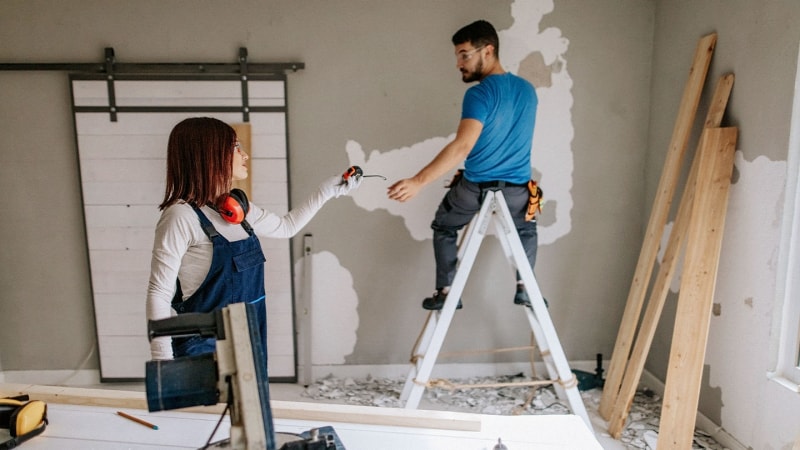Tips for buying a fixer upper

Quick insights
- When buying a fixer-upper, it’s important to be realistic about the scope of work to renovate, as well as your skillset, time and resources.
- When selecting a home for renovations, assess the location, layout, type of damage and structural integrity.
- Building contingency into your budget, working with the right contractors and monitoring your project to completion are also helpful steps to take when renovating.
If you’re interested in buying a fixer-upper house, you’ve come to the right place. In this article, we’ll talk through tips on buying a fixer-upper: what to know before you take the plunge, how to buy a fixer upper house and where to start with your renovations.
What to know before buying a fixer-upper
Before deciding to buy a fixer-upper, there’s at least three elements you should reflect on:
- The scope of work: Each fixer-upper property comes with a unique assortment of projects. How much are you willing to take on? Even for those experienced with home repairs, it can be challenging to accurately estimate the cost and time that will go into a renovation.
- Your skillset: What is your skill-level for home repairs? How about your tolerance for setbacks? Buyers who are knowledgeable and passionate about working with their hands and able to weather ups and downs might succeed more easily.
- Available time and resources: Even the best-planned renovation project can push the budget or require more time than anticipated. When assessing a fixer-upper, it’s better to overestimate financial and time costs. Those experienced with renovations may want to set aside an additional 10-20% into their budget for contingencies.
These can be challenging questions to face, but it’s important to be realistic. Many ambitious homebuyers have underestimated the scope of a project and overestimated their skillset, time and resources—with disastrous outcomes.
How to buy a fixer-upper house and renovate with ROI in mind
Now that you have a primer on the considerations that go into fixer-upper projects, let’s look at one way the process could play out, step-by-step.
Step 1: Buying a fixer-upper: what to do first
The first thing you'll need to do is find the right house for you to fix up. Here are some aspects to consider:
- Location and market trends: Whether you’re buying the home for personal use or as an investment property, location matters. For example, a home in an area with rising property values could see a greater increase in value when renovated for better return-on-investment (ROI).
- Structural integrity: Homes with significant structural damage may take more time, money and effort to repair than they are worth. Keep an eye out for properties with cracks in the foundation and severe mold or water damage.
- Layout and usability: How well does the home’s existing floor plan, fixtures and windows align with modern expectations (or your preferences)? For example, older homes may have smaller, compartmentalized rooms, which may require tearing down walls for a more spacious feel.
Step 2: Conduct inspections and ROI analysis
Be ready to communicate with the owner (or listing agent) and get full details on the property’s condition. A professional home inspection can help identify the repairs needed so you can begin estimating the costs. If you plan to use contractor help for any or all repairs, collecting quotes at this stage is essential. This can also be the right time to look ahead for any permits or regulations that may have an impact on your plan.
Using the information you've gathered, ask yourself, will the property’s value increase enough to justify the expense? Put another way, once all repairs are made, is the home likely to have comparable value to renovated properties in the area?
Step 3: Purchase the property and plan strategic renovations
When you feel you’ve found a home whose repairs can be managed and justified, take steps to finalize the purchase. If your offer is accepted and you close on the home, congrats—but the work has just begun! As soon as possible, finalize plans for high-ROI renovations and repairs to any critical areas identified in your inspection. Finally, be aware of home improvements that may not add much value.
Step 4: Execute renovations and manage budget
As renovations get underway, it’s important to continuously monitor your planned (and unplanned) renovations and budget. Even with the expectation that things will change and a built-in contingency budget, it can be easy for dollars and time to slip away. Working with the right contractors can help keep your project on-track.
Financing options for buying and renovating a fixer-upper
There are many different options for homebuyers looking to pursue a fixer-upper project, including:
- Fannie Mae HomeStyle® renovation loans: HomeStyle loans are designed specifically for homebuying with a planned renovation. With this type of loan, the lender is very closely involved in both the planning and execution of the project, including managing a designated escrow account with funds set aside for renovations.
- Freddie Mac CHOICERenovation® loans: CHOICERenovation loans can provide a single-closing option for homeowners looking to buy a home and finance renovations. There are two subtypes of these loans, the full version and CHOICEreno eXPress® loans, which are intended for smaller-scale projects.
- FHA 203(k) loans: Federally-backed options include Standard 203(k) loans for major rehabilitation and Limited 203(k) loans for less expensive improvements. When compared to conventional loans, these typically have more lenient eligibility requirements, which may make them appealing to first-time homebuyers. However, these renovation-focused loans may have lower maximums which vary by location.
Chase doesn't offer these types of loans.
Why people consider buying fixer-uppers
There are many reasons a person would choose to buy a fixer-upper over a new or remodeled home. For one, fixer-upper properties typically have a lower purchase price, with the potential for customization and equity growth as repairs are made. Second, not everyone is prepared to take on a big project when shopping for a home, so you may find that there’s less competition at the bargaining table. And finally, for certain handy homeowners, nothing beats the sense of accomplishment when the job’s done.
In summary
If you have the time, resources and willingness, a fixer-upper house could be a great investment or opportunity to unlock your dream home by customizing it. However, with renovation projects, it’s helpful to expect the unexpected. Building contingencies into your budget and monitoring progress can help keep you on track. If you’re ready to explore your lending options, consider getting in touch with a Chase Home Lending Advisor.



